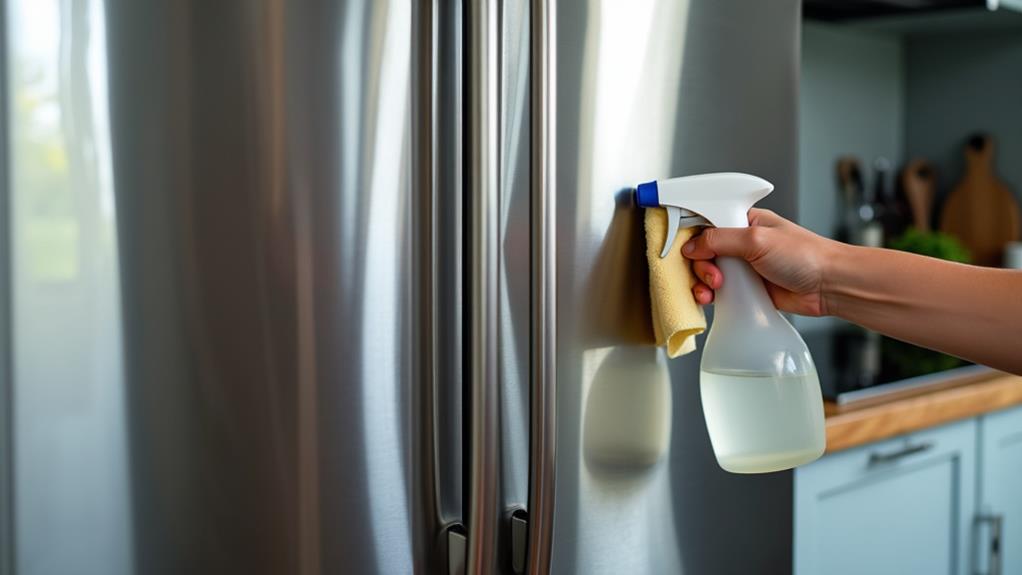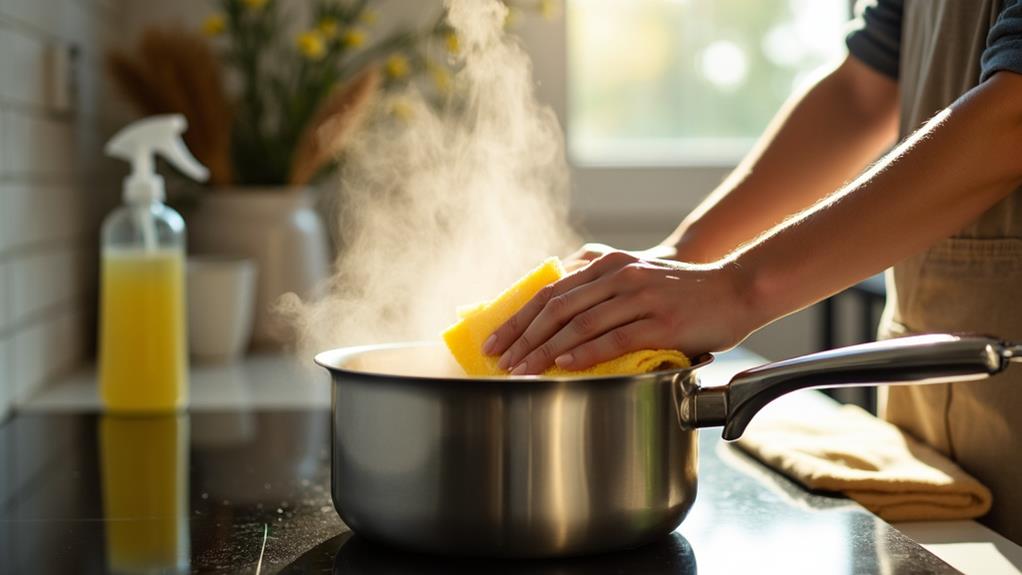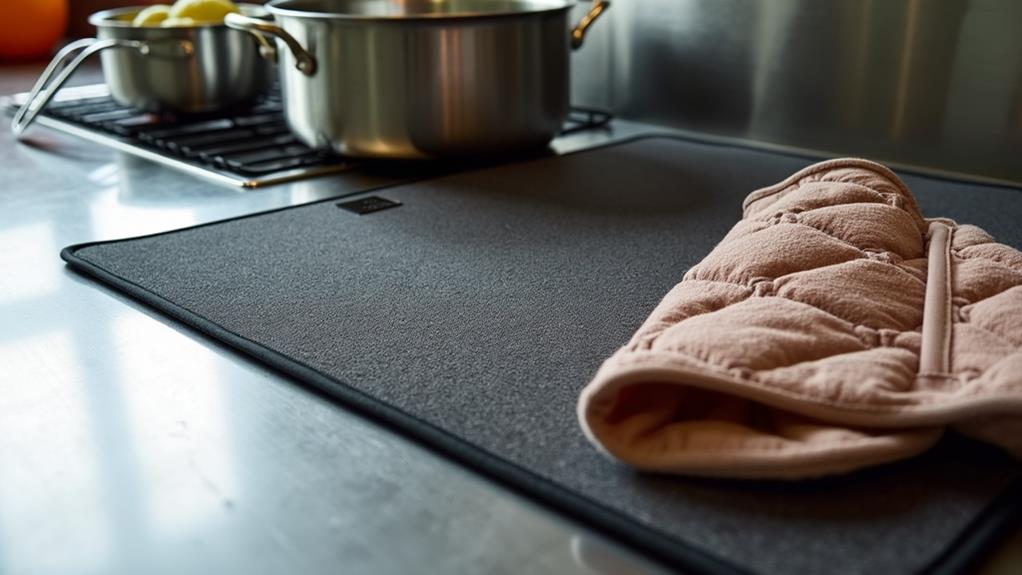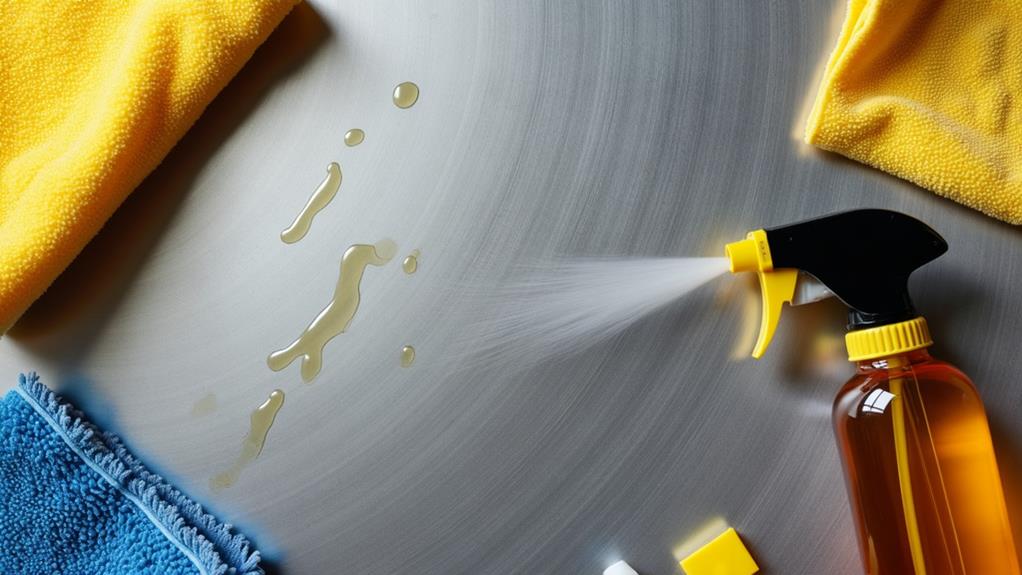How to Refinish Dull Stainless Steel Surfaces
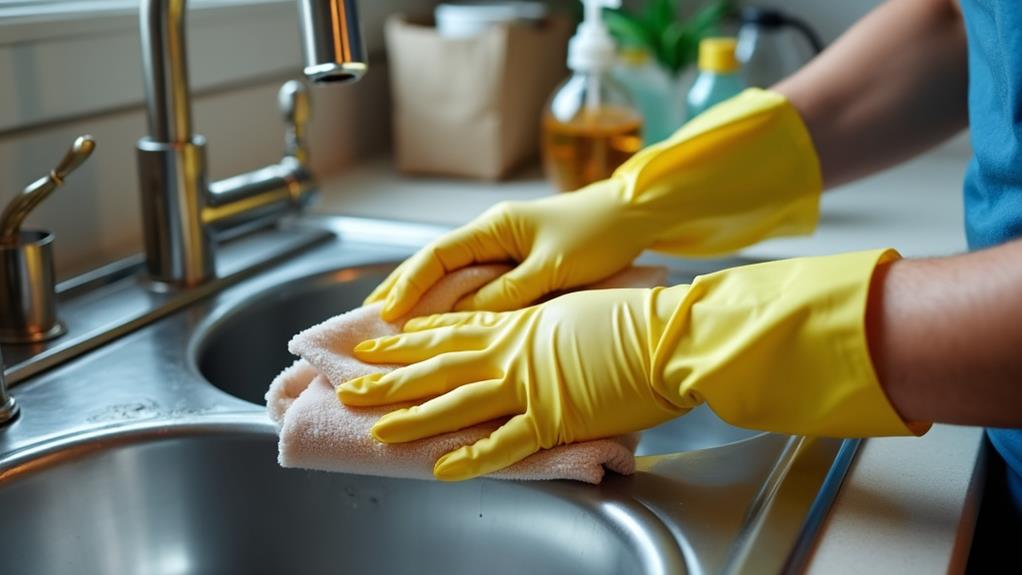
To rejuvenate dull stainless steel surfaces, start by gathering supplies like stainless steel-specific cleaners, microfiber cloths, and protective coatings. Clean thoroughly with warm soapy water, then tackle rust and stains using a paste of baking soda and water or commercial rust removers. Sand the surface gently in the direction of the grain using fine grit sandpaper. Apply a small amount of polish with a clean cloth and buff using circular motions for a flawless finish. Protect with a high-quality sealant and maintain the shine with regular cleaning. For more details and expert tips, continue exploring refinement techniques.
Gather Necessary Supplies
Before you start refinishing your dull stainless steel surfaces, you'll need to gather the required supplies. Initially, make certain you have a variety of cleaning agents on hand. These will help you remove any grime, grease, or stains from the surfaces. Look for stainless steel-specific cleaners, as they are formulated to be effective yet gentle on the metal. You'll also need some mild dish soap and water for initial cleaning steps.
Next, you'll want to have protective coatings ready. These coatings are crucial for giving your stainless steel a shiny, polished look while also providing a layer of protection against future tarnishing and fingerprints. Options include specialized stainless steel polishes and sealants that are easy to apply and long-lasting.
Don't forget about the tools you'll need. Soft microfiber cloths are ideal for wiping and applying cleaning agents and protective coatings without scratching the surface. Non-abrasive sponges can also be useful for tougher spots that need a bit more elbow grease.
Lastly, make sure you have gloves and maybe even a face mask to protect yourself from any fumes or harsh chemicals. With everything gathered, you're ready to move on to the next step.
Clean the Surface
To begin, thoroughly clean the stainless steel surface to remove any dirt, grime, or residue. This step is essential for effective stainless steel care and guarantees a smooth refinishing process. Here's a simple yet effective method to get started:
- Wipe Down: Use a soft cloth dampened with warm, soapy water to wipe down the entire surface. This initial cleaning helps to lift surface grime.
- Scrub Gently: For stubborn spots, dip a non-abrasive sponge into a mixture of water and mild dish soap. Gently scrub in the direction of the stainless steel's grain to avoid scratches.
- Rinse: Carefully rinse the surface with clean water to remove any soap residue. It's significant to verify no cleaning agents remain, as they can interfere with the refinishing process.
- Dry Thoroughly: Use a microfiber cloth to dry the surface completely. This not only prevents water spots but also gives you a clear view of any areas that may need extra attention.
Remove Rust and Stains
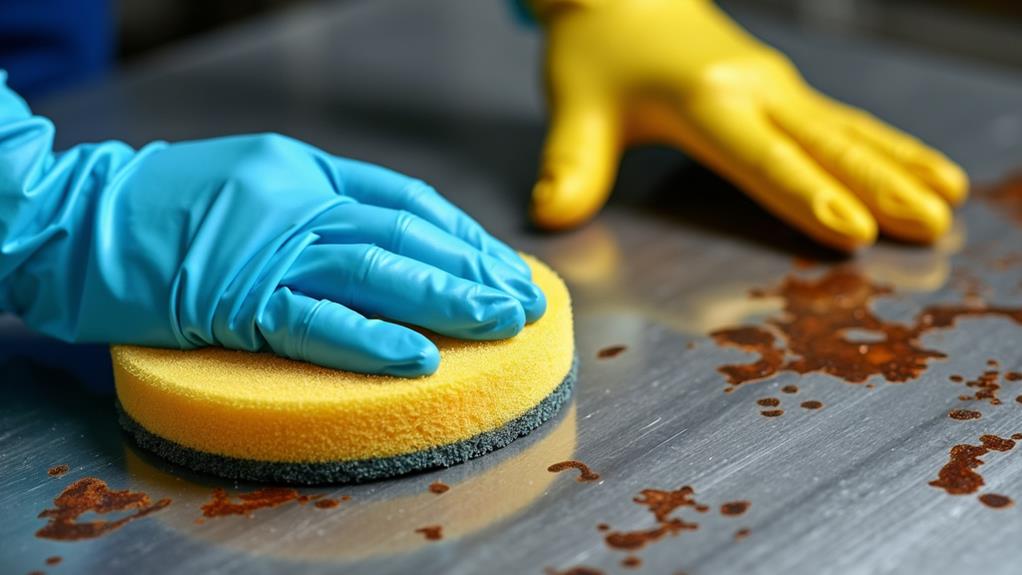
With the stainless steel surface now spotless, the next step focuses on tackling any rust and stains that may have developed over time. Rust removal is essential to restore your stainless steel's original shine and prevent further deterioration. Begin by creating a paste using baking soda and water. Apply this paste to the rusted areas and let it sit for about 15 minutes. Using a soft-bristle brush, gently scrub the rust spots until they disappear.
For more stubborn rust, you might need a commercial rust remover. Always follow the manufacturer's instructions and confirm the area is well-ventilated. Apply the remover, wait the recommended time, then wipe it off with a clean cloth.
Stain prevention is just as significant after rust removal. Regular maintenance can keep your stainless steel looking pristine. Wipe the surface with a mixture of vinegar and water to eliminate any potential stains before they set in. Dry the area thoroughly with a soft cloth to prevent water spots.
Sand the Surface
Sanding the stainless steel surface is a key step in restoring its smoothness and shine. You'll need to use the right sanding techniques and grit selection to achieve the best results. Here's how you can do it:
- Choose the Right Grit: Start with a coarser grit, like 120, if the surface is heavily scratched or dull. For minor imperfections, you can begin with a finer grit, around 220. Always finish with an even finer grit, such as 400, to smooth the surface thoroughly.
- Sand in One Direction: To maintain a uniform appearance, always sand in the direction of the existing grain. Moving in a circular motion or against the grain can create extra scratches and make the finish look inconsistent.
- Use Even Pressure: Apply consistent pressure as you sand to avoid gouges or uneven areas. Too much pressure can damage the surface, while too little won't effectively smooth out imperfections.
- Check Your Progress: Periodically wipe the surface with a damp cloth to remove sanding debris and check your progress. This helps you see if you need to sand more or if you're ready to move to a finer grit.
Apply a Polish
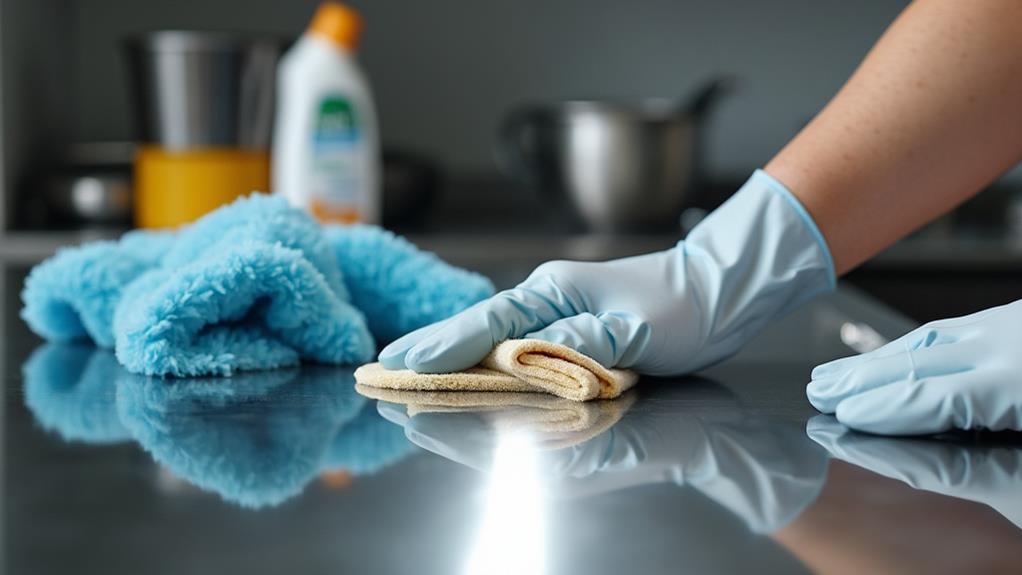
Now that you've sanded the surface, it's time to apply a polish to bring out the stainless steel's natural shine. Initially, let's talk about polish types. You can choose between liquid, cream, or paste polishes. Liquid polishes are easy to apply and work well for light tarnish. Cream polishes offer a bit more abrasion for moderate dullness. Paste polishes are the heaviest-duty option, perfect for surfaces with significant wear.
Once you've selected the appropriate polish, it's essential to apply it correctly. Start by putting a small amount of polish on a clean, soft cloth. Using circular motions, rub the polish onto the stainless steel surface. Make sure to cover the entire area evenly. The circular motion helps distribute the polish and works it into the fine scratches, filling them and enhancing the shine.
After applying the polish, let it sit for a few minutes as per the manufacturer's instructions. This waiting period allows the polish to work its magic, lifting grime and oxidation. Don't rush this step; patience will yield better results.
Buff the Surface
Once the polish has had time to work, the next step is to buff the surface to a high shine. Buffing is vital because it removes any remaining polish residue and improves the stainless steel's luster. You'll need some important buffing products and techniques to get the job done effectively.
First, choose the right buffing pad. Microfiber cloths are a popular choice because they're gentle on the surface and efficient at picking up any leftover polish. Alternatively, a soft buffing wheel attached to a power tool can make the process faster if you're dealing with a larger area.
Here's a step-by-step guide to buffing:
- Apply Light Pressure: Start by applying light pressure with your microfiber cloth or buffing wheel. Too much pressure can cause scratches, so be gentle.
- Use Circular Motions: Move in circular motions to guarantee even coverage and to avoid streaks. This technique helps you get a uniform shine.
- Frequent Inspection: Regularly check your progress. Pause to inspect for any missed spots or areas requiring extra attention.
- Repeat if Necessary: Sometimes, one pass isn't enough. Don't hesitate to go over the surface again to achieve the perfect shine.
Protect the Finish
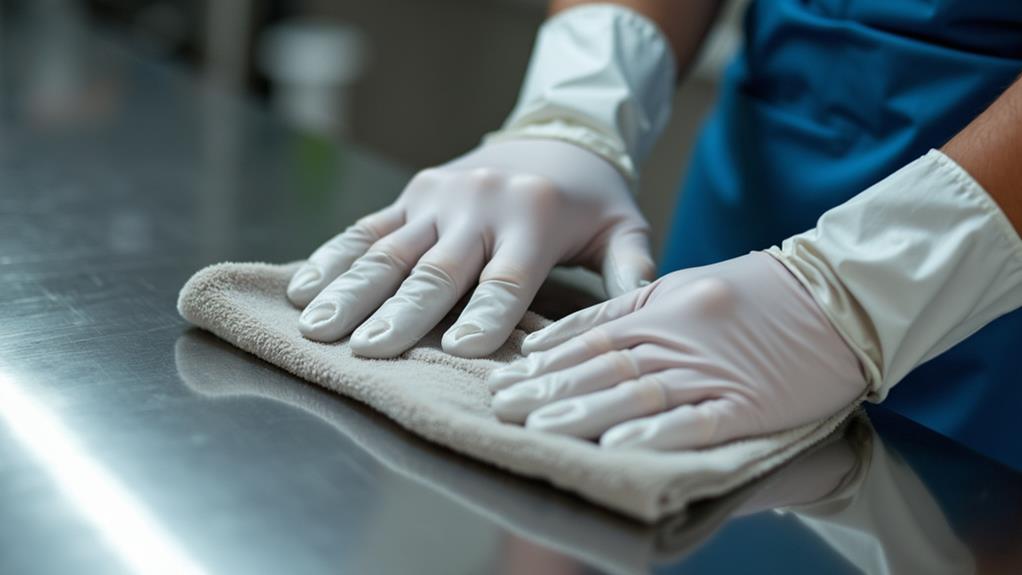
To guarantee your refinished stainless steel surface stays looking pristine, it's vital to protect the finish. Begin by applying a high-quality stainless steel sealant. This will provide a layer of surface protection, shielding the steel from fingerprints, smudges, and potential scratches. Make sure to choose a sealant specifically designed for stainless steel to provide optimal protection.
After applying the sealant, let it cure according to the manufacturer's instructions. This curing process is critical for finish preservation, ensuring the protective layer bonds properly with the steel. Once cured, your surface will be more resistant to everyday wear and tear.
Additionally, avoid using abrasive cleaning tools or harsh chemicals on the refinished surface. These can damage the protective layer and compromise the finish. Instead, opt for a soft microfiber cloth and a gentle cleaner designed for stainless steel. Wipe down the surface regularly to maintain its pristine appearance without harming the protective seal.
Lastly, consider placing protective pads or coasters under any items that may scratch the surface. Taking these simple steps will help guarantee your refinished stainless steel remains in prime condition for years to come.
Maintain the Shine
Maintaining the shine of your refinished stainless steel surface is just as critical as protecting its finish. Proper shine maintenance guarantees your surface remains gleaming and elegant over time. Here are some practical steps for long term care:
- Regular Cleaning: Clean your stainless steel regularly using a soft cloth and a mixture of mild soap and warm water. Avoid abrasive cleaners that can scratch the surface. Rinse with clean water and dry thoroughly to prevent water spots.
- Use Stainless Steel Cleaners: Invest in a good quality stainless steel cleaner or polish. These products are specifically designed for shine maintenance. Apply them with a soft cloth, following the grain of the steel, and buff to a shine.
- Wipe with the Grain: Always clean and polish your stainless steel in the direction of the grain. This helps avoid streaks and maintains the surface's natural finish.
- Avoid Harsh Chemicals: Steer clear of bleach and other harsh chemicals that can damage the finish and dull the shine. If you need to disinfect, opt for milder solutions like diluted vinegar.
Troubleshoot Common Issues
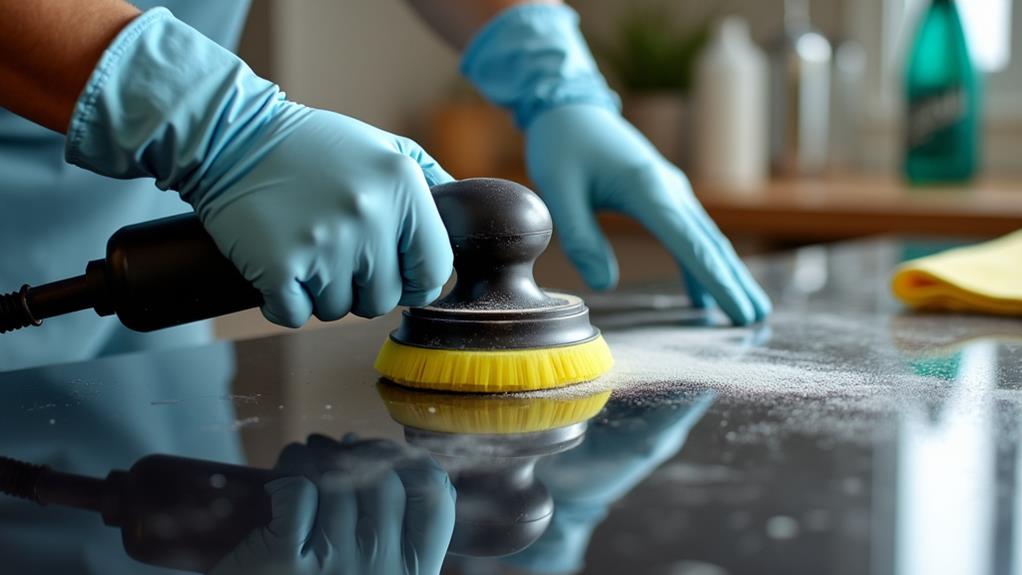
Even with diligent maintenance, you may encounter common issues when refining stainless steel surfaces. One frequent problem is scratches, which can mar the sleek look of your stainless steel. For effective scratches removal, start by choosing the right abrasive material. Fine-grit sandpaper or non-abrasive pads work well. Always rub in the direction of the grain to avoid further damage.
Another issue you might face is improper surface preparation. Before you begin any refinishing work, the surface must be thoroughly cleaned. Use a non-abrasive cleaner to remove any dirt, grease, or residue. This guarantees that your refinishing efforts yield a smooth and even finish. Skipping this step often leads to unsatisfactory results and could even make the scratches more noticeable.
Sometimes, you might also deal with streaks or discoloration after refinishing. To combat this, use a clean microfiber cloth and a stainless steel polish. Apply the polish in circular motions and buff until the surface shines. This not only improves the appearance but also adds a protective layer to the steel.

